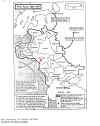|
|||
|
Since Sudilkov lay squarely in the
middle of the Pale of Settlement, it is worthwhile
taking a closer look at this historical region. In 1795, Russia annexed a large chunk of Poland, which already had a high concentration of Jewish inhabitants. The German Czarina Catherine II encouraged Germans to immigrate into her expanding empire. Many, including a large number of Jews, took up her offer and moved into present day Poland and Belarus. Prof. Stephen Wheatcroft of the University of Melbourne, in a lecture entitled “Anti-Semitism and the Basis of Ultra-Nationalism in Tsarist Russia” (May 5, 1997; available on the Internet), argues that Catherine, “In her first proclamations after the annexation of the Polish provinces... promised to maintain the existing order and religious liberties of all inhabitants, including the Jews: ‘The administration of law and justice among Jews shall continue to be entrusted to their present courts, though in the name and under the authority of Her Imperial Majesty’”. (Wheatcroft cites S. Baron, The Russian Jew under the Tsars and Soviet Union, pp.103-4) However, her apparent benevolence was in fact only superficial. In order to prevent the Jews from spreading out and settling further east into Russia proper, Catherine created the Pale of Settlement, confining them within a fixed geographical area. This can be understood in part as her response to the resistance of Russian merchants who, suddenly forced to compete against Jewish traders in Moscow and other cities, did not wish to relax their grip on lucrative markets. They therefore conspired with Catherine to restrict the Jews to the new regions of the empire in the west where they would pose no economic threat. In April, 1835 Czar Nicolas I gave the Pale greater legal definition with a new set of decrees and statutes. The region retained its boundaries with only minor modifications until its abolition by the Bolsheviks in 1917. While it existed Jews were not only barred from crossing into Russia proper, but from residing in the cities of Kiev, Nikolaev, Sebastopol and Yalta, except with a special residence permit. The Pale was gradually reduced in area by the edicts of successive czars, giving rise to increasingly difficult living conditions. The population rapidly grew to unsustainable levels as waves of immigrants continued to pour in. Inside the Pale the government increasingly interfered with the free movement of Jews, ultimately displacing entire populations in accordance with its strategies for land ownership and distribution. In 1882 a half-million Jews living in rural areas in the Pale were forced to abandon their homes and live in shtetls or designated towns, while a quarter-million Jews living along the western frontier of Russia were driven inside. An additional 700,000 Jews living east of the Pale were forced in by 1891. In the same year 2,000 Jews were ousted from St. Petersburg and exiled to the Pale, many in chains. Another 20,000 were deported there from Moscow, where Jews had been permitted to live freely since 1865. In 1897, according to official census figures, there were 4,899,300 Jews living in the Pale, constituting 11.6% of its total population. In some urban areas the Jews actually constituted the majority of inhabitants. “More than 5 million Jews—about half of the Jewish people—lived in the Russian Empire (Poland included) at the end of the nineteenth century. More than 90% lived in the Pale of Settlement.” (A Teacher’s Guide to the Holocaust, cited above) The policies of the czarist government with regard to the Jews were infected with a particularly vicious form of anti-Semitism. When on February 9, 1911 the Duma began debating whether to eliminate the Pale of Settlement, extreme nationalists were bitterly opposed. Markoff, one of the most prominent among them, exclaimed, “You already know my views on the Jewish race, a criminal race and one that hates mankind... The Jews were restricted [to the Pale] not because of evil inclinations of other nations, including the Russian nation... but because all the states of the world, all the nations, defended themselves against the attacks of the criminal Jewish race on their well-being, on their very souls.... The Jewish force is extraordinary, almost superhuman... The state alone is powerful enough to resist this dreadful power...” (cited from A. B. Tager’s book, pp. 19-20) On the same day the 7th Congress of the United Nobility convened in St. Petersburg in order to state its position on the debate. The Congress suggested that it was best “not to abolish the Pale of Settlement,... but to clear Russia of the Jews, to clear it consistently, without hesitation, step by step, in accordance with a previously prepared plan.” (A. B. Tager). The organizers of the Congress presented a special essay on the question which included a lengthy memorandum on ritual murders allegedly committed by the Jews in accordance with their religion. Markoff, once again the main speaker on the issue, declared, “All the Jews must be driven within the Pale of Settlement—this is the first act... The second act is to drive them out of Russia entirely.” (A. B. Tager) It is no wonder that such ignorance and hate on the part of the Russian government inevitably resulted in violence and killing. |
